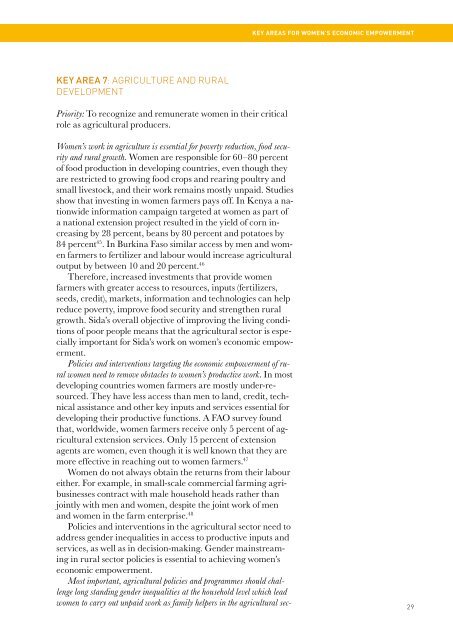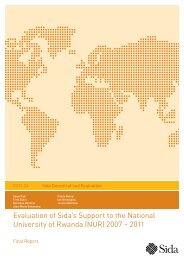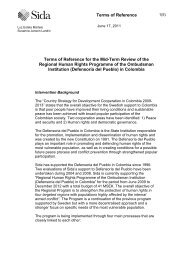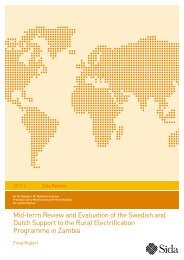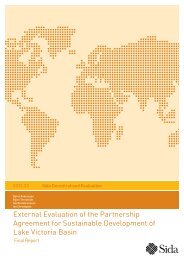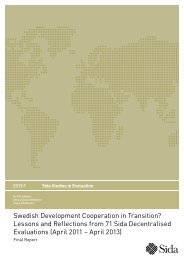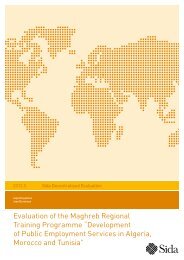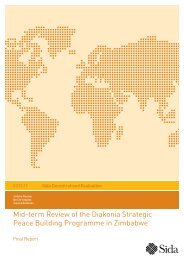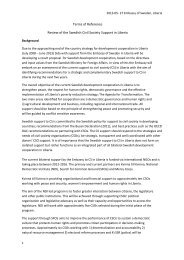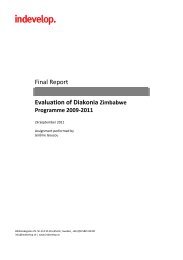Women's Economic Empowerment: Scope for Sida's Engagement
Women's Economic Empowerment: Scope for Sida's Engagement
Women's Economic Empowerment: Scope for Sida's Engagement
Create successful ePaper yourself
Turn your PDF publications into a flip-book with our unique Google optimized e-Paper software.
KEY AREAS FOR WOMEN’S ECONOMIC EMPOWERMENTKey area 7: Agriculture and ruraldevelopmentPriority: To recognize and remunerate women in their criticalrole as agricultural producers.Women’s work in agriculture is essential <strong>for</strong> poverty reduction, food securityand rural growth. Women are responsible <strong>for</strong> 60–80 percentof food production in developing countries, even though theyare restricted to growing food crops and rearing poultry andsmall livestock, and their work remains mostly unpaid. Studiesshow that investing in women farmers pays off. In Kenya a nationwidein<strong>for</strong>mation campaign targeted at women as part ofa national extension project resulted in the yield of corn increasingby 28 percent, beans by 80 percent and potatoes by84 percent 45 . In Burkina Faso similar access by men and womenfarmers to fertilizer and labour would increase agriculturaloutput by between 10 and 20 percent. 46There<strong>for</strong>e, increased investments that provide womenfarmers with greater access to resources, inputs (fertilizers,seeds, credit), markets, in<strong>for</strong>mation and technologies can helpreduce poverty, improve food security and strengthen ruralgrowth. Sida’s overall objective of improving the living conditionsof poor people means that the agricultural sector is especiallyimportant <strong>for</strong> Sida’s work on women’s economic empowerment.Policies and interventions targeting the economic empowerment of ruralwomen need to remove obstacles to women’s productive work. In mostdeveloping countries women farmers are mostly under-resourced.They have less access than men to land, credit, technicalassistance and other key inputs and services essential <strong>for</strong>developing their productive functions. A FAO survey foundthat, worldwide, women farmers receive only 5 percent of agriculturalextension services. Only 15 percent of extensionagents are women, even though it is well known that they aremore effective in reaching out to women farmers. 47Women do not always obtain the returns from their laboureither. For example, in small-scale commercial farming agribusinessescontract with male household heads rather thanjointly with men and women, despite the joint work of menand women in the farm enterprise. 48Policies and interventions in the agricultural sector need toaddress gender inequalities in access to productive inputs andservices, as well as in decision-making. Gender mainstreamingin rural sector policies is essential to achieving women’seconomic empowerment.Most important, agricultural policies and programmes should challengelong standing gender inequalities at the household level which leadwomen to carry out unpaid work as family helpers in the agricultural sec-29


